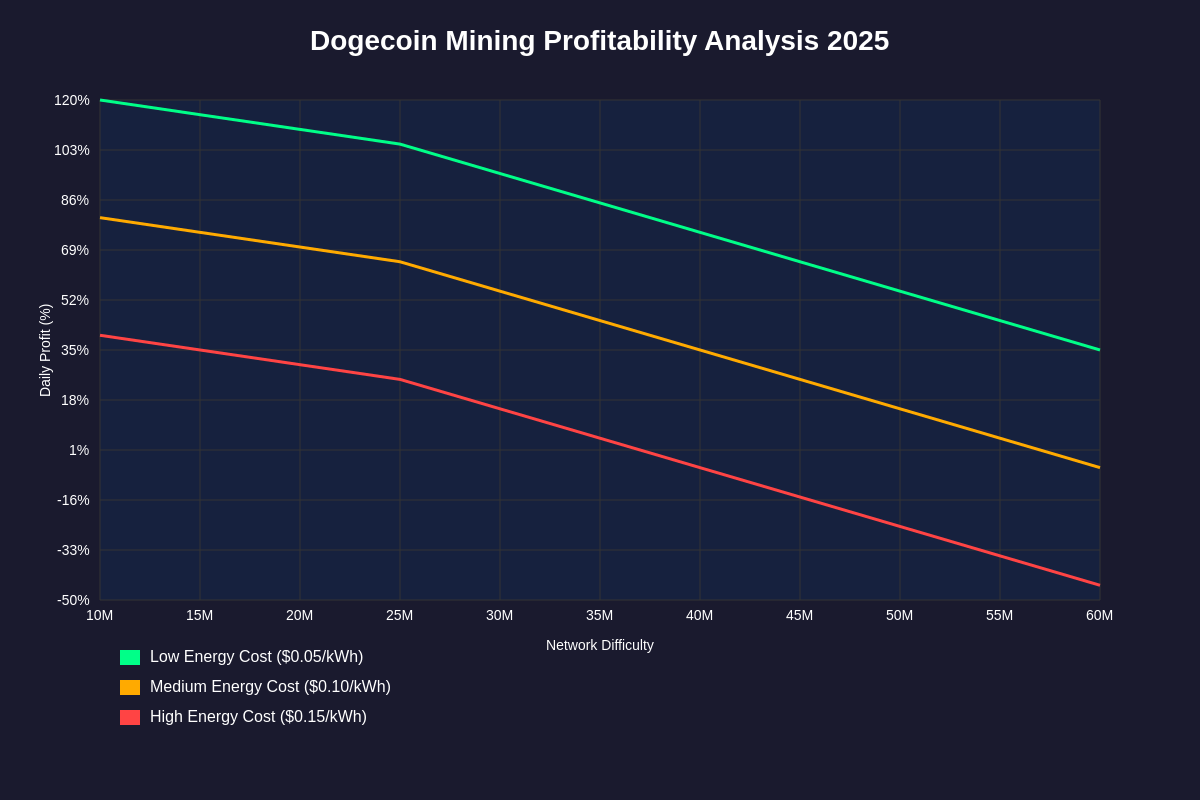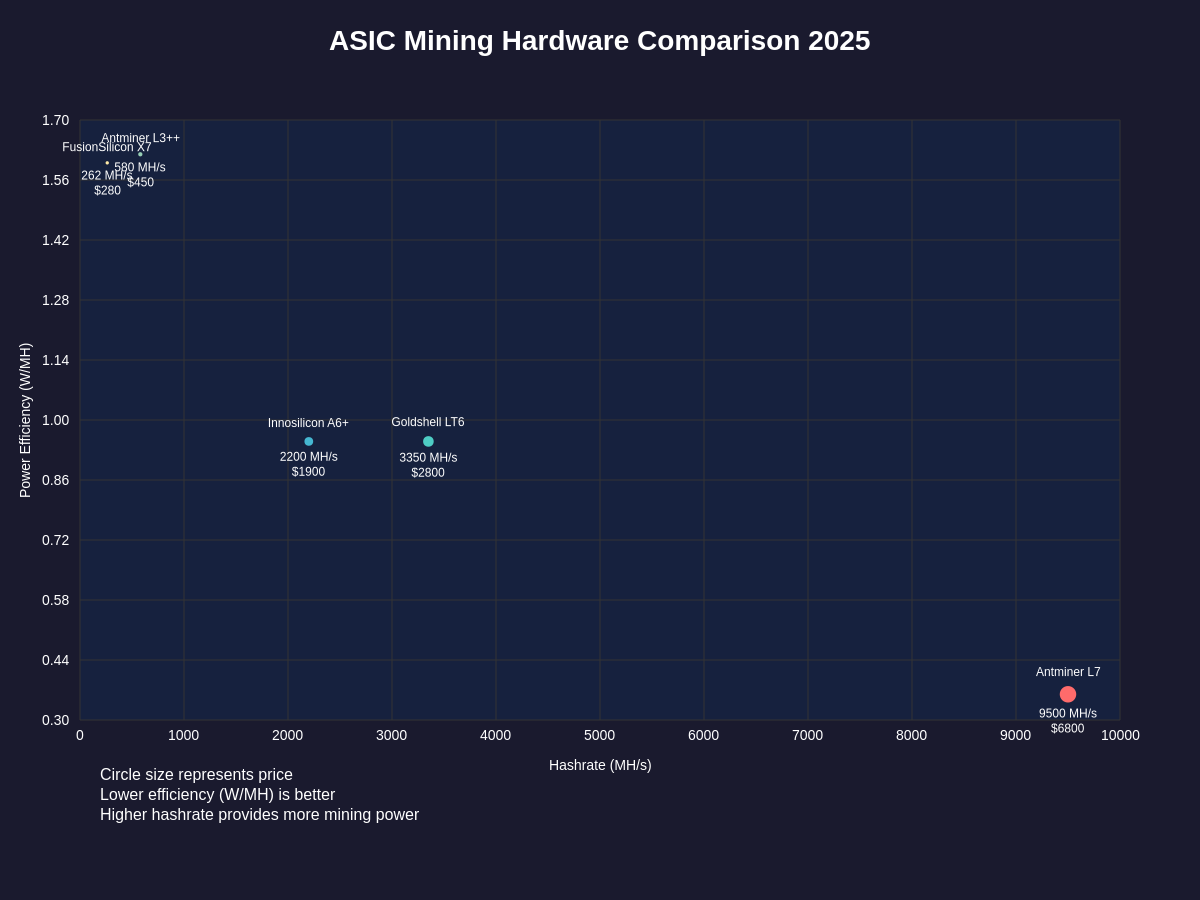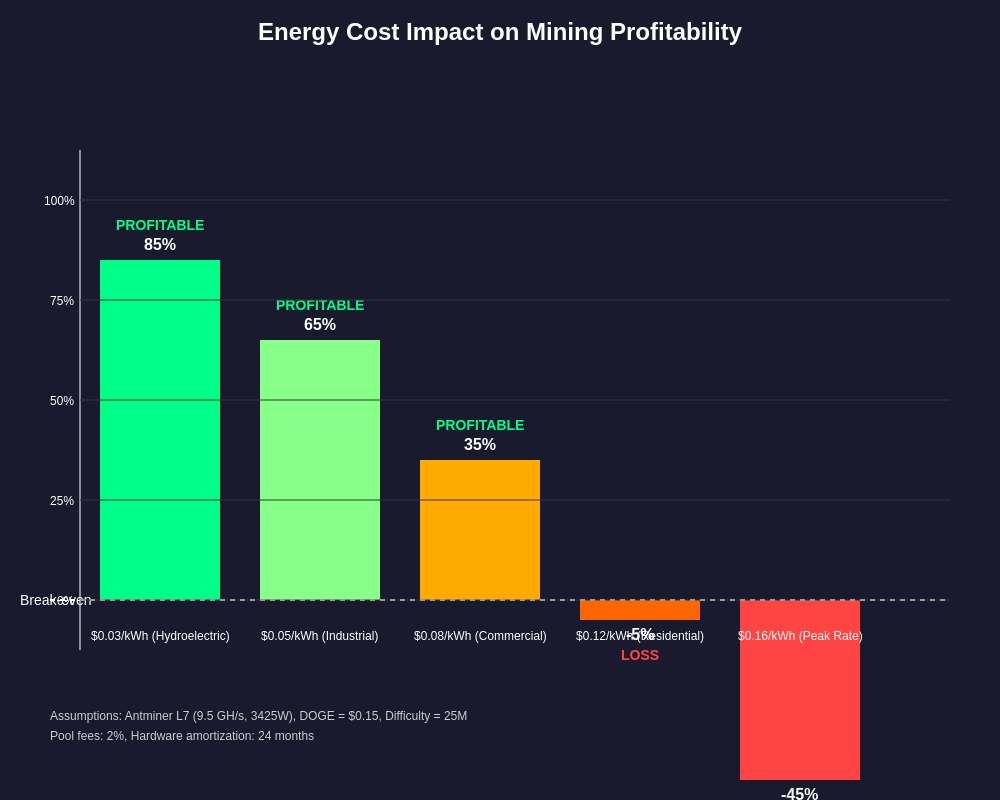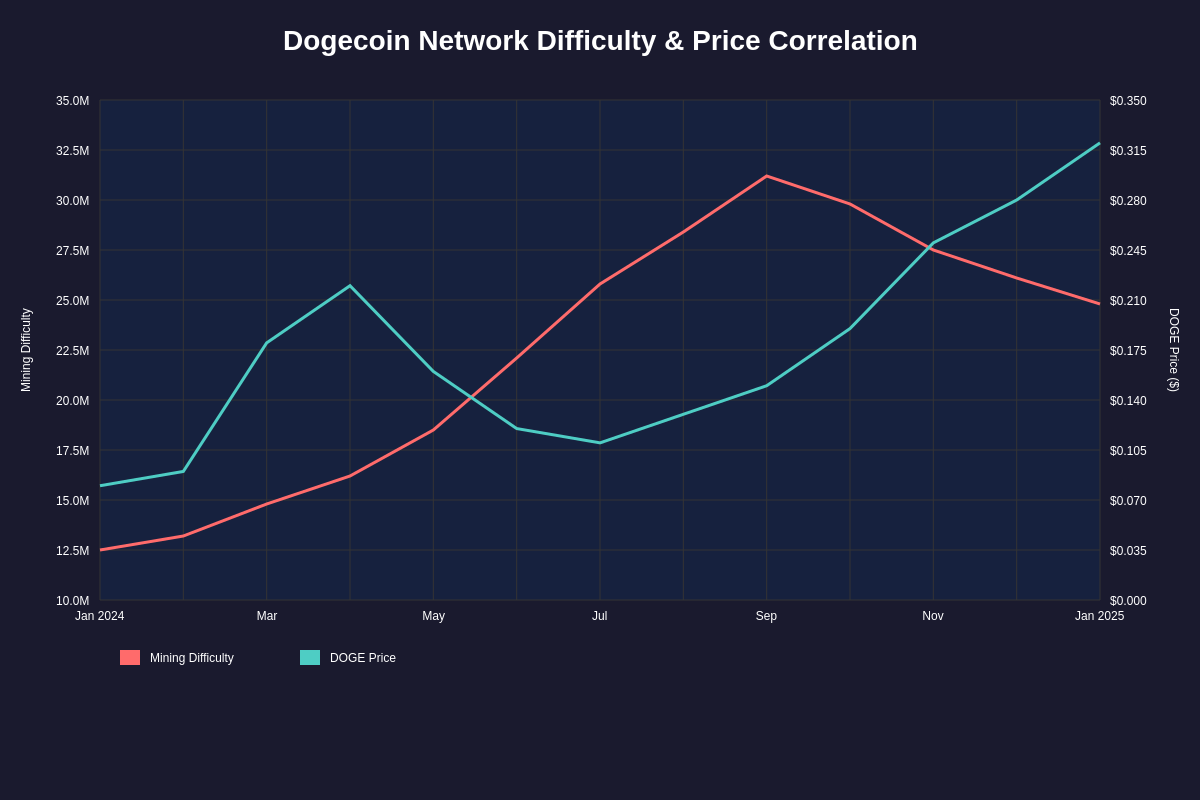The Current State of Dogecoin Mining Economics
The profitability of Dogecoin mining in 2025 has become an increasingly complex equation involving network difficulty adjustments, hardware costs, energy expenses, and market volatility that requires careful consideration of multiple variables to determine potential returns. The cryptocurrency mining landscape has evolved dramatically since Dogecoin’s inception, with the transition from GPU mining to ASIC dominance fundamentally altering the economics of participation in the Dogecoin network.

The merge mining relationship between Dogecoin and Litecoin has created unique economic dynamics that differentiate DOGE mining from other cryptocurrency operations, allowing miners to simultaneously earn rewards from both networks while contributing computational power to secure both blockchains. This symbiotic relationship has provided additional revenue streams for miners while increasing the overall security of the Dogecoin network through shared computational resources.
Mining difficulty adjustments in 2025 reflect the ongoing competition among miners and the network’s ability to maintain consistent block times despite fluctuating hash rates. The difficulty algorithm’s responsiveness to changes in mining participation ensures network stability while directly impacting individual miner profitability through its influence on the probability of successfully mining blocks.
The current mining rewards structure for Dogecoin provides miners with 10,000 DOGE per block, with block times averaging approximately one minute, creating a predictable reward schedule that forms the foundation for profitability calculations. However, the actual rewards received by individual miners depend on their contribution to mining pools or their success in solo mining operations, making pool selection and mining strategy critical factors in overall profitability.
Hardware Requirements and ASIC Mining Dominance
The evolution of Dogecoin mining hardware from consumer-grade GPUs to specialized ASIC miners has fundamentally transformed the mining landscape, creating significant barriers to entry for casual miners while establishing industrial-scale operations as the dominant force in network security. Modern ASIC miners designed for Scrypt-based cryptocurrencies like Dogecoin offer hash rates and energy efficiency levels that make GPU mining economically unviable for most participants.
Current generation ASIC miners such as the Antminer L7 and similar devices provide hash rates measured in gigahashes per second while consuming several kilowatts of electrical power, representing a significant capital investment that must be amortized over the expected lifespan of the equipment. The rapid pace of hardware development means that mining equipment can become obsolete within two to three years, requiring continuous reinvestment to maintain competitive hash rates.

The geographic distribution of ASIC manufacturing and the concentration of production among a limited number of suppliers creates supply chain risks and cost considerations that affect mining profitability. Miners must consider not only the initial purchase price of equipment but also shipping costs, import duties, and the potential for supply shortages that could delay deployment or increase acquisition costs.
Hardware maintenance and replacement costs represent ongoing operational expenses that must be factored into long-term profitability calculations. ASIC miners operate in harsh environments with high temperatures and continuous operation, leading to component failures that require technical expertise and spare parts inventory to address promptly without significant downtime.
The secondary market for used mining equipment provides both opportunities and risks for miners seeking to optimize their hardware investments. While purchasing used ASICs can reduce initial capital requirements, the uncertainty around remaining operational lifespan and potential hidden defects must be weighed against the cost savings achieved through used equipment acquisition.
Energy Costs and Environmental Considerations
Electricity costs represent the largest ongoing operational expense for most Dogecoin mining operations, with energy efficiency becoming the primary determinant of long-term profitability in competitive mining environments. The relationship between local electricity rates and mining profitability creates geographic advantages for miners with access to low-cost energy sources, including hydroelectric, nuclear, and renewable energy facilities.
Industrial electricity rates vary significantly across different regions and jurisdictions, with some areas offering rates below $0.05 per kilowatt-hour while others exceed $0.15 per kilowatt-hour, creating dramatic differences in operational costs that can determine the viability of mining operations. Miners must carefully evaluate electricity contracts, including demand charges, power factor penalties, and time-of-use pricing structures that can significantly impact overall energy costs.
The environmental impact of cryptocurrency mining has become a significant consideration for both individual miners and institutional operations, with increasing focus on renewable energy sources and carbon-neutral mining practices. Many large-scale mining operations have committed to using renewable energy sources or purchasing carbon offsets to address environmental concerns while potentially benefiting from lower long-term energy costs.
Power infrastructure requirements for large-scale mining operations include not only adequate electrical capacity but also proper cooling systems, backup power solutions, and electrical distribution equipment capable of handling the high power densities associated with ASIC mining farms. These infrastructure investments represent significant capital requirements that must be included in comprehensive profitability analysis.
Energy efficiency improvements in newer generation ASIC miners continue to drive obsolescence of older equipment, as miners with access to the most efficient hardware gain competitive advantages in low-margin environments. The watts per gigahash metric has become a critical specification for evaluating mining hardware, with efficiency improvements directly translating to improved profitability or extended operational viability as network difficulty increases.

Mining Pools vs Solo Mining Analysis
The choice between joining mining pools or attempting solo mining represents a fundamental strategic decision that affects both the frequency and variability of mining rewards, with each approach offering distinct advantages and disadvantages depending on the miner’s hash rate, risk tolerance, and operational objectives. Mining pools aggregate the computational power of multiple participants to increase the probability of successfully mining blocks while distributing rewards proportionally based on contributed hash rate.
Pool mining provides more predictable and frequent payouts compared to solo mining, reducing the variance in daily or weekly earnings that can create cash flow challenges for mining operations with ongoing operational expenses. The steady income stream from pool mining allows for more accurate financial planning and budgeting, making it particularly attractive for miners who rely on mining revenue to cover electricity costs and equipment financing payments.
Solo mining offers the potential for larger individual rewards when successfully mining blocks, but with significantly higher variance that can result in extended periods without any rewards followed by substantial payouts. The probability of successfully solo mining depends directly on the miner’s hash rate relative to the total network hash rate, making solo mining economically viable only for miners with substantial computational resources.
Pool fee structures vary significantly among different mining pools, with fees typically ranging from 1% to 3% of mining rewards, directly impacting net profitability. Miners must evaluate pool fees in conjunction with payout frequency, minimum payout thresholds, and the reliability of pool operations when selecting pool partners for their mining operations.
The geographic location of mining pools can affect latency and connection reliability, potentially impacting the efficiency of mining operations through increased stale share rates or connection interruptions. Miners should consider multiple pool options and backup configurations to ensure continuous mining operations and optimize their share of successfully mined blocks.
Market Volatility and Price Impact on Profitability
Dogecoin’s price volatility creates significant uncertainty in mining profitability calculations, with dramatic price movements capable of transforming profitable operations into loss-generating activities within short time periods. The correlation between Dogecoin price movements and broader cryptocurrency market trends means that mining profitability is subject to both Dogecoin-specific developments and general market sentiment affecting all digital assets.
Historical price analysis reveals patterns of extreme volatility in Dogecoin valuation, with price increases of several hundred percent followed by significant corrections that can eliminate mining profitability for extended periods. Miners must develop strategies for managing this volatility, including decisions about when to sell mined coins versus holding for potential future appreciation.

The relationship between mining difficulty and price creates feedback loops that can amplify or moderate the impact of price changes on individual miner profitability. When prices decline, some miners may shut down operations, leading to difficulty adjustments that can improve profitability for remaining miners, though this adjustment process can take time to manifest.
Forward pricing mechanisms and cryptocurrency derivatives markets provide tools for miners to hedge price risk and lock in future selling prices for their mining production. However, these hedging strategies require sophisticated financial knowledge and may not be accessible or appropriate for smaller mining operations.
The psychological impact of price volatility on mining decisions can lead to suboptimal timing of equipment purchases, operational scaling decisions, and selling strategies that affect long-term profitability. Successful miners often develop disciplined approaches to price volatility that separate operational decisions from short-term market movements.
Regulatory Environment and Tax Implications
The regulatory landscape surrounding cryptocurrency mining continues to evolve across different jurisdictions, with new regulations potentially affecting the legal status, taxation, and operational requirements for mining activities. Miners must stay informed about regulatory developments in their operating jurisdictions and consider the potential impact of future regulatory changes on their operations.
Tax treatment of mining rewards varies significantly among different tax jurisdictions, with some treating mined cryptocurrency as taxable income at the time of receipt while others may allow for different timing or valuation approaches. The complexity of cryptocurrency taxation requires professional tax advice for most mining operations to ensure compliance and optimize tax strategies.
Environmental regulations and energy usage restrictions in some jurisdictions create additional compliance requirements and potential operational limitations for mining operations. Some regions have implemented restrictions on cryptocurrency mining due to energy consumption concerns, while others have embraced mining as an economic development opportunity.
The classification of mining activities as business operations versus investment activities affects tax treatment, deduction eligibility, and regulatory compliance requirements. Professional miners may be able to deduct operational expenses including equipment depreciation, electricity costs, and facility expenses, while hobbyist miners may face more limited deduction opportunities.
International mining operations must consider currency exchange regulations, import/export restrictions on mining equipment, and potential differences in legal frameworks that could affect operational continuity and profitability. The global nature of cryptocurrency markets contrasts with the local nature of regulatory compliance, creating complexity for miners operating across multiple jurisdictions.
Profitability Calculators and Financial Modeling
Accurate profitability analysis for Dogecoin mining requires sophisticated financial modeling that incorporates multiple variables including hardware costs, electricity expenses, network difficulty projections, and price assumptions to provide meaningful projections of potential returns on investment. Online profitability calculators provide basic estimates but may not capture the full complexity of mining economics or account for individual operational circumstances.
Comprehensive financial models for mining operations should include sensitivity analysis to evaluate how changes in key variables affect profitability outcomes, allowing miners to understand the risks associated with their investments and identify the most critical factors for success. Monte Carlo simulations can provide probabilistic assessments of profitability under different scenarios, offering more nuanced insights than simple point estimates.
The time value of money and discount rate assumptions significantly impact the net present value calculations for mining investments, requiring careful consideration of appropriate discount rates that reflect the risks associated with cryptocurrency mining operations. The high volatility and technological obsolescence risks associated with mining suggest higher discount rates than traditional investments.
Break-even analysis helps miners understand the minimum price levels, maximum electricity costs, or maximum network difficulty levels that allow for profitable operations, providing clear operational targets and risk management parameters. Understanding break-even points enables miners to make informed decisions about when to suspend or resume operations based on market conditions.
Cash flow modeling becomes particularly important for mining operations that require ongoing financing or have significant operational expenses, as positive mining profitability on paper may not translate to positive cash flows if equipment financing payments or other fixed costs are not adequately considered in the analysis.
Future Outlook and Technology Developments
The future of Dogecoin mining profitability will be influenced by continued improvements in ASIC technology, changes in energy costs and availability, regulatory developments, and the overall adoption and price performance of Dogecoin as a cryptocurrency. Technological improvements in mining hardware efficiency will continue to drive competitive pressures while potentially improving profitability for miners who can access the latest equipment.
Integration of renewable energy sources and energy storage technologies may provide opportunities for miners to reduce operational costs while addressing environmental concerns associated with cryptocurrency mining. Solar power installations combined with battery storage systems could enable mining operations to achieve greater energy cost predictability and reduced environmental impact.
The development of more efficient cooling technologies and alternative cooling approaches such as immersion cooling may reduce the total cost of ownership for mining operations while enabling higher power densities and improved equipment reliability. These technological developments could improve the economic viability of mining in regions with higher ambient temperatures or limited cooling infrastructure.
Potential changes to the Dogecoin protocol, including any modifications to block rewards, difficulty adjustment algorithms, or consensus mechanisms, could significantly impact mining economics and profitability projections. Miners should monitor development discussions and protocol upgrade proposals that might affect their operations.
The continued growth of merged mining opportunities with other Scrypt-based cryptocurrencies could provide additional revenue streams for Dogecoin miners, improving overall profitability while sharing operational costs across multiple cryptocurrency networks. The expansion of merged mining compatibility could create new opportunities for diversified mining revenue streams.
Risk Management Strategies for Miners
Successful Dogecoin mining operations require comprehensive risk management strategies that address price volatility, technology obsolescence, regulatory changes, and operational risks that could significantly impact profitability and operational continuity. Diversification across multiple mining activities, geographic locations, or revenue streams can help reduce concentrated risks associated with single-cryptocurrency mining.
Equipment redundancy and maintenance strategies become critical for maintaining operational uptime and avoiding revenue losses due to hardware failures or maintenance requirements. Miners should develop relationships with equipment suppliers and service providers to ensure rapid response to equipment issues and access to replacement parts when needed.
Financial risk management includes maintaining adequate cash reserves to cover operational expenses during periods of reduced profitability, establishing credit facilities for equipment purchases or operational funding, and potentially using financial instruments to hedge price or currency risks. The cyclical nature of mining profitability makes financial planning and risk management essential for long-term success.
Insurance coverage for mining operations may include property insurance for equipment and facilities, business interruption insurance for operational continuity, and cyber liability insurance for digital asset security risks. The specialized nature of mining operations may require customized insurance solutions that address the unique risks associated with cryptocurrency mining.
Contingency planning for various scenarios including extended periods of unprofitability, regulatory changes, equipment obsolescence, or facility access issues helps ensure operational resilience and the ability to adapt to changing market conditions. Regular review and updating of contingency plans keeps risk management strategies current with evolving operational and market conditions.
Comparison with Alternative Investment Options
Evaluating the risk-adjusted returns of Dogecoin mining compared to alternative investment opportunities provides important context for investment decisions and helps determine whether mining represents an attractive use of capital relative to other options. Direct cryptocurrency investment through purchasing and holding Dogecoin eliminates operational complexity while maintaining exposure to price appreciation potential.
Traditional investment alternatives including stocks, bonds, real estate, and other asset classes offer different risk and return profiles that should be considered when evaluating mining investments. The high volatility and operational complexity of mining may not be appropriate for investors seeking more stable or passive investment opportunities.
Other cryptocurrency mining opportunities including Bitcoin, Ethereum staking, or alternative cryptocurrency mining may offer different profitability profiles and risk characteristics that provide superior risk-adjusted returns compared to Dogecoin mining. Comparative analysis of different mining opportunities helps optimize mining investment decisions.
The liquidity characteristics of mining investments differ significantly from most traditional investments, with mining equipment representing illiquid physical assets that may be difficult to sell quickly or at attractive prices during market downturns. This liquidity risk should be considered when comparing mining to more liquid investment alternatives.
The active management requirements of mining operations including monitoring, maintenance, and ongoing operational decisions represent significant time commitments that should be valued when comparing mining returns to passive investment alternatives. The opportunity cost of time spent managing mining operations affects the true return on investment calculations.
Understanding the correlation between mining profitability and broader economic conditions helps investors assess how mining investments might perform during different economic scenarios and whether mining provides diversification benefits relative to traditional investment portfolios. The relationship between energy costs, technology adoption, and cryptocurrency prices creates complex correlation patterns that require careful analysis.
Disclaimer: This article is for informational purposes only and does not constitute financial, investment, or legal advice. Cryptocurrency mining involves significant risks including market volatility, regulatory changes, and technology obsolescence. Past performance does not guarantee future results. Readers should conduct their own research and consult with qualified professionals before making any investment or mining decisions. The profitability of mining operations depends on numerous factors that can change rapidly and unpredictably.